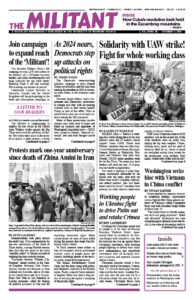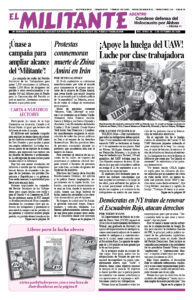Drawn together by common interests in countering Beijing’s expansionist course, Nguyen Phu Trong, general secretary of Vietnam’s ruling Communist Party, met with President Joseph Biden in Hanoi Sept. 10.
“The United States is a Pacific nation, and we’re not going anywhere,” Biden said afterward. Washington has been strengthening its alliances across the Pacific in the wake of sharpening conflicts with Beijing, especially since Moscow’s war on Ukraine.
Over the last five months, Biden has welcomed the Philippines’ president to the White House for the first time in over a decade and hosted prime ministers and presidents from India, Japan and South Korea. For years the U.S. rulers have sought to contain Beijing’s challenge to their decadeslong supremacy in the Pacific, Washington’s biggest prize since it emerged as top dog at the end of the second imperialist world war.
The Vietnamese government used the meeting to confer “comprehensive strategic partnership” status on Washington, a designation it reserved for the rulers of China, Russia, India and South Korea until now, seeking to boost its own foothold as a manufacturing hub in the region. With economic growth in China slowing, and Moscow weakened and isolated, the Vietnamese government has sought deeper ties with rulers in the U.S., Australia, Japan and Singapore.
China remains Vietnam’s main source of raw materials. But U.S.-Vietnam trade has ballooned in recent years as companies, including Apple, Nike and Intel, shifted manufacturing away from China. Workers’ wages are lower in Vietnam.
Senior executives from Google, Intel, Boeing and other U.S. companies met with Vietnamese firms in Hanoi Sept. 11 to hammer out plans to deepen trade. Supply chains of semiconductors are the centerpiece of the discussions, along with access to minerals used to make computer components. Vietnam has the world’s largest deposits after China.
Washington lifted its arms embargo of Vietnam in 2016 and has sold it two coast guard vessels. Hanoi has expressed interest in buying F-16 fighter jets. Moscow currently supplies 80% of Vietnam’s armaments.
“The upgrading of the U.S.-Vietnam relationship carries huge significance given Washington’s complicated history with Hanoi,” CNN said Sept. 10. What it meant by “complicated” was the deployment of 8 million U.S. military personnel over two decades to try to crush the struggle of the Vietnamese people for self-determination and to reunify their country.
Millions in Vietnam, Laos and Cambodia were slaughtered as the U.S. rulers dropped more bombs than in all previous wars combined, before Washington went down to a historic defeat in 1975.
Just four years later, after capitalism was overturned in Vietnam, troops from the People’s Republic of China invaded Vietnam, the bitter fruit of the Chinese Communist Party’s efforts to deepen its collaboration with the U.S. imperialists at the time. Washington hadn’t given up on finding a way to turn back the conquests of the Vietnamese Revolution.
The situation is markedly different today. Vietnamese and U.S. leaders see common goals against Beijing’s advances. In 2014 Beijing moved an oil rig into waters claimed by Vietnam. This August, Hanoi protested after Beijing conducted military drills and forbade other vessels from entering an area that includes the Paracel Islands, claimed by both Vietnam and Taiwan.
China’s coast guard has stepped up enforcement of Beijing’s territorial claims, repeatedly expelling Vietnamese fishing boats. Since 2014, 98 Vietnamese boats have been destroyed by Chinese vessels.

